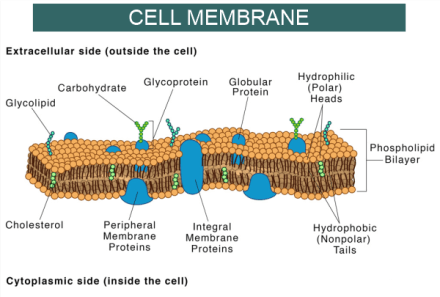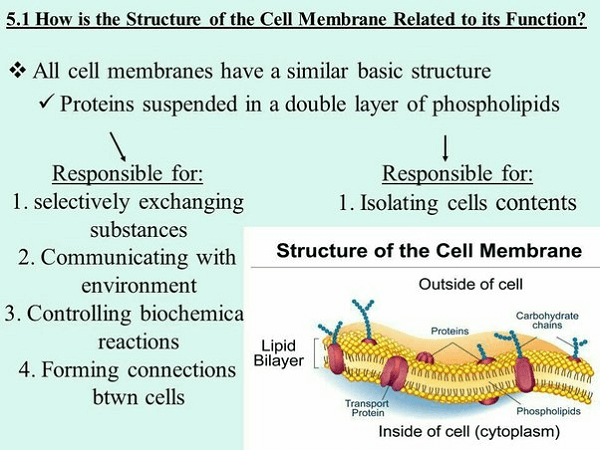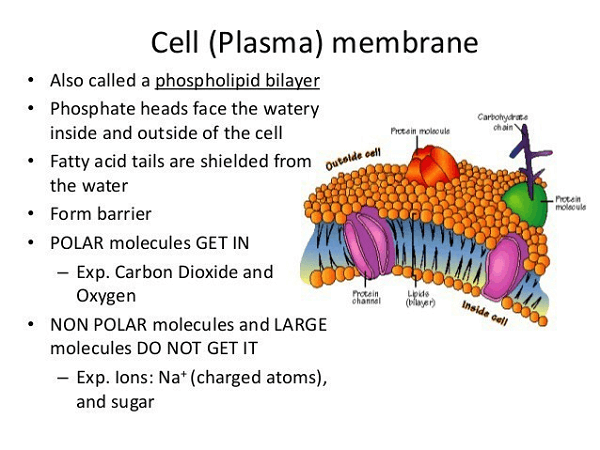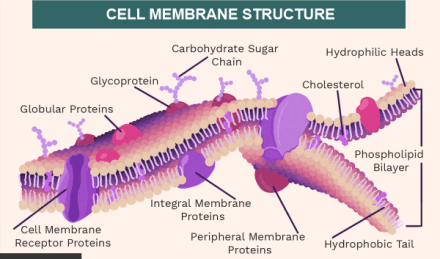Cell Membrane DefinitionIntroductionThe plasma membrane, also called the cell membrane, is a delicate layer that encompasses and encircles each cell, serving as a barrier that regulates the movement of substances in and out of the cell. Composed of a lipid bilayer consisting of two layers of phospholipid molecules, the cell membrane's hydrophilic heads face outward and interact with the aqueous environments on each side of the membrane, while its hydrophobic tails face inward. Additionally, the cell membrane includes a variety of proteins and molecules that perform crucial functions in cell signaling, transport, and other cellular processes. 
Cell Membrane ExplainedThe thin and flexible layer surrounding and enclosing the contents of a cell is known as the cell membrane or plasma membrane. This structure plays a vital role in biology, acting as a barrier that regulates the movement of substances into and out of the cell and maintaining a balance between the cell and its environment. The cell membrane is primarily composed of a double layer of phospholipid molecules. The arrangement of these molecules is such that the hydrophilic heads face outward, towards the aqueous environment inside and outside the cell. In contrast, the hydrophobic tails face inward, away from this environment. This structure is commonly referred to as a lipid bilayer. Embedded in the lipid bilayer are proteins that serve various functions, such as transporting molecules in and out of the cell, cell signaling, and adhering to other cells or the extracellular matrix. Certain proteins span the entire membrane width, forming channels or transporters that enable specific molecules to cross the membrane. Other proteins are anchored to one side of the membrane and act as receptors that respond to environmental signals. The cell membrane is selectively permeable, allowing some molecules to pass through while preventing others from crossing. Small, non-polar molecules, such as oxygen and carbon dioxide, can diffuse freely across the membrane, while larger molecules, like proteins and sugars, require specific transport proteins to cross. Additionally, the cell membrane helps maintain the proper balance of ions and other solutes inside the cell, which is crucial for normal cellular function. 
Components of Cell Membrane1. Phospholipids All living organisms have a cell membrane composed of phospholipids, a lipid molecule. These molecules' hydrophilic head and hydrophobic tail enable them to form a bilayer in aqueous environments. This bilayer acts as a barrier that separates the cell's interior from its surroundings while permitting the passage of specific molecules. Phospholipids have additional roles, including functioning as signaling molecules and participating in the cell's transport of lipids and proteins. 2. Peripheral proteins Peripheral proteins are a type of cell membrane protein that is located on the outer surface of the lipid bilayer. Unlike integral proteins, they are not embedded in the membrane but rather loosely attached to the inner or outer membrane surface. Their functions include critical roles in cell signaling, cell-cell communication, and cell adhesion. Peripheral proteins frequently bind to other proteins or molecules and can be effortlessly separated from the membrane using mild detergents or changes in pH. 3. Cholesterol Cholesterol, an important lipid molecule, is a crucial element of animal cell membranes that contributes to their structural integrity and fluidity. It also has a significant role in producing hormones, vitamin D, and bile acids. However excessive cholesterol can cause cardiovascular disease, but it is also necessary for proper bodily function. Adopting a healthy lifestyle and diet can maintain cholesterol levels, and medication can be taken as a last resort. 4. Carbohydrates Carbohydrates, proteins, and lipids are the three primary types of biomolecules. These organic compounds are made up of carbon, hydrogen, and oxygen and provide both structural support and energy to cells. Carbohydrates come in various forms, such as monosaccharides (single sugars), disaccharides (two sugars linked together), and polysaccharides (long chains of linked sugars). Glucose, sucrose, and starch are some familiar examples of carbohydrates. 5. Integral proteins Cell membrane components known as integral proteins span the lipid bilayer and are integrated within it. These proteins consist of hydrophobic regions that interact with the non-polar tails of lipids and hydrophilic regions that interact with the aqueous environment inside and outside the cell. Integral proteins serve vital functions such as facilitating cell signaling, transporting molecules across the membrane, and promoting cell-cell interactions. Additionally, they provide essential structural support to the cell membrane. 
The function of the Cell Membrane1. Protection The function of the cell membrane is to protect the cell by controlling the movement of molecules in and out of it. The membrane is composed of a phospholipid bilayer, and it contains embedded proteins that regulate the flow of substances across the membrane. By being selectively permeable, the cell membrane maintains the internal environment of the cell and safeguards it from harmful external agents like toxins and pathogens. Additionally, the cell membrane plays a crucial role in maintaining the cell's structure and providing structural support. 2. Holding cell content The term "holding cell content" pertains to the function of the cell membrane in maintaining a boundary between the internal and external environments of the cell. The cell membrane's selective permeability enables certain substances to pass while hindering others from entering or exiting the cell. This mechanism plays a critical role in upholding the appropriate concentration of ions, nutrients, and waste products within the cell, enabling it to perform its functions efficiently. 3. Selective permeability The ability of the cell membrane to permit certain substances to pass through while blocking others from entering or exiting the cell is known as selective permeability. Embedded proteins act as gatekeepers, regulating the movement of molecules across the hydrophobic barrier created by the phospholipid bilayers that make up the membrane. Selective permeability plays a crucial role in maintaining a stable internal environment and facilitating selective interactions with the surrounding environment, which are necessary for the cell's proper functioning and survival. 4. Shape The function of a cell heavily relies on the shape of its membrane, which plays a crucial role in various aspects, such as the transportation of molecules, structural stability, and interaction with the environment or other cells. The composition of the membrane and the cytoskeleton, a protein fiber network that offers structural support, determine its shape. Alterations in the membrane shape are observed during cell division, endocytosis, and exocytosis, allowing the cell to perform diverse functions. 5. Organelles Eukaryotic cells contain specialized structures called organelles that perform vital functions necessary for the cell's survival. These organelles are enclosed by a membrane that safeguards them and controls the movement of substances in and out of the organelle. Furthermore, the cell membrane has a vital role in maintaining the internal environment of the organelle by selectively permitting only specific molecules to cross it. The proper functioning and execution of the roles of organelles, such as mitochondria, lysosomes, and endoplasmic reticulum, depend on the cell membrane. 6. Compartmentalization The function of the cell membrane, known as compartmentalization, is essential as it involves separating and isolating different cellular components and activities into distinct regions within the cell. It acts as a selectively permeable barrier, and the cell membrane regulates the movement of molecules in and out of the cell to maintain a specific cellular environment optimal for cellular function. This mechanism enables the cell to conduct its biochemical processes without being affected by external or internal disturbances. 7. Cell Recognition The capacity of a cell membrane to recognize and engage with other cells or molecules is known as cell recognition. This ability is crucial for various cellular functions, including immune response, tissue formation, and cell signaling. Specific proteins and glycoproteins on the cell membrane's surface enable recognition by binding to complementary molecules in other cells. Through this recognition process, cells can distinguish between self and non-self and collaborate with other cells in the body to coordinate their actions. 8. Cell Metabolism Maintaining cellular functions and energy production occur through chemical reactions collectively known as cell metabolism. This process is essential to regulating molecule transportation into and out of the cell, primarily carried out by the cell membrane. The membrane's selective permeability enables the cell to manage nutrient and waste product levels and engage with the environment and other cells. Additionally, enzymes within the cell membrane facilitate metabolic reactions such as ATP production, further emphasizing its importance in cell metabolism. 9. Antigens Antigens are molecules present on the surface of cells that trigger an immune response. In the case of cell membranes, antigens play several important functions, such as determining blood grouping, immune response, and the acceptance or rejection of a transplant. For example, the major histocompatibility complex (MHC) antigens on the plasma membrane play a critical role in graft rejection by recognizing foreign cells and triggering an immune response against them. Therefore, antigens are essential for immune recognition and regulation in the body. 
ConclusionThe cell membrane is an essential element in every living cell, serving as a boundary separating the internal cellular milieu from the outside world. It consists of a double layer of phospholipids, which creates a selectively permeable boundary that regulates the transport of substances into and out of the cell. Furthermore, the membrane has various proteins and other molecules that aid cell signaling, transport, and attachment. The absence of a cell membrane would render the cell incapable of maintaining its internal environment and executing vital activities. Consequently, the cell membrane is a critical determinant of the survival and function of living cells.
Next TopicCell Organelles Definition
|
 For Videos Join Our Youtube Channel: Join Now
For Videos Join Our Youtube Channel: Join Now
Feedback
- Send your Feedback to [email protected]
Help Others, Please Share









